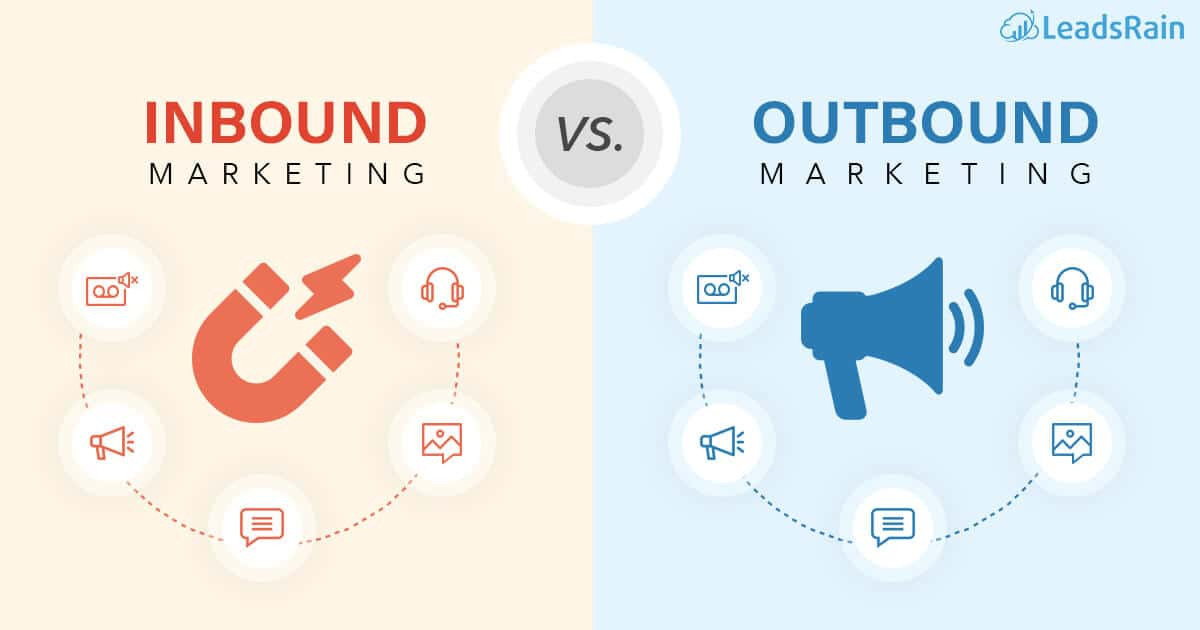
IN marketing, you either hunt for customers (outbound) or attract them (inbound). This article will explain the difference between outbound and inbound marketing, the pros and cons of each, and how best to leverage them for your marketing success.
Before diving in, here are some key terms in the marketing world, particularly digital marketing.
Outbound marketing
Have you ever been interrupted by an advert on social media while scrolling through the feed?
Outbound marketing is when you go after people to buy your product or service; you basically intrude in people’s lives with your product or service.
Social media “sponsored advertisements”, YouTube advertisements, traditional advertising media such as TV and radio adverts, billboards, flyer handouts, cold calling are all outbound marketing forms. Essentially, these things interrupt or invade people’s space.
When you present your product to random people you are reaching out to what is called a “cold audience”; people not interested in whatever you are selling.
You may get some interested people if you have done your targeting right (more on that later). Outbound marketing involves reaching out to a cold audience, hoping to attract some interested buyers. You have to persuade people to buy into your product, for example, through cold-calling.
- Business opinion: Branding in the age of entrepreneurship and industrialisation (Part 23)
- Business opinion: Branding in the age of entrepreneurship and industrialisation (Part 23)
- Bus operators pledge to end crisis
- Branding and the customer purchase journey
Keep Reading
Inbound marketing
With inbound marketing, you attract people naturally without actively reaching out to them.
How do you attract people?
Have value: Have something valuable that solves people’s problems. People are attracted to value;
Create helpful content: Create content that educates and helps people with their problems, for example blogs, videos, guides, free eBooks, among other platforms. Content builds trust. Instead of selling right off the bat, you educate and nurture people, making you an expert and authority in the field. Once you have value and content, you must make sure people can find it. You have to be on platforms (places) where people are actively searching for things;
Search Engines (SEO): Create a website with content and information people are searching for;
YouTube: Creating helpful videos that educate; and
Social media: Create social media pages or personal brands sharing valuable content;
Groups and forums: Join niche-focused forums and groups and share helpful tips instead of selling immediately: people will gravitate towards you.
Inbound marketing is about creating value that attracts people naturally.
Think people such as Jerry, The Chartered Vendor. He is known as the “sales guru” because of his helpful videos. He is one of the most sought-after business consultants in Zimbabwe.
Pros, cons of outbound marketing
Outbound marketing is typically for getting customers quickly. You do not wait for customers to come to you, you go to them, hence making outbound methods more suitable for commodity-based products that mainly compete on price like salt, pushing volumes and short promos.
Pros
Fast: You can get customers immediately. You don’t wait for customers; you go to them;
Wider reach: The more people who see your advert the more potential customers;
Initial awareness: Can make a new brand known; and
Easier to set up: You can put up an advertisement with relative ease.
Cons
Low trust: You have to do a lot of persuasion for people to trust you and your product;
Less qualified leads: Depending on how well you have targeted people, outbound marketing usually yields customers with a low-buying potential;
Can be expensive: You have to spend large sums of money to reach more people;
Intrusive: Adverts can be annoying and intrusive, reducing conversion. People can disable adverts from showing up or throw away flyer handouts; and
Short-term gains: Outbound methods such as cold calling require constant reaching out to people. Customers stop coming when you stop calling.
Pros, cons of inbound marketing
Inbound marketing is a long-term game with long-term rewards. You do not get results immediately, but sustainable customers in the long run.
Inbound methods usually work well for service-based businesses or high-priced products where you need to build trust and value so that people buy into your product or service. However, you can still use inbound methods on any product to build trust and value.
Pros
Automatic lead generation: People come on their own looking for solutions;
Long-term benefits: You create content once and people keep coming for it in the future;
Builds trust: People slowly trust your products when you give out helpful information and show expertise reducing the need for persuasion;
Qualified leads: Inbound marketing ensures you get qualified customers who are more likely to buy;
Less expensive: You get free organic traffic, for example from Google without spending money; and
Increases brand authority: The more you give helpful content the more people see you as an expert in the industry and want to buy your products or services.
Cons
Takes time: Inbound methods take long to see results; and
More effort: Creating and optimising content, for example to rank higher in searches, requires more effort and time.
Inbound marketing stats
Inbound marketing proves to be beneficial, especially in this digital era where people are bombarded with advertisements and sceptical about some products.
The internet boom saw a different marketing approach: Helping people first instead of the traditional methods of selling right away.
Research shows that inbound strategies outperform outbound methods. According to sender, inbound marketing generates 54% more leads than outbound methods. Many people prefer organic results than sponsored advertisements in searches.
Doing outbound marketing rightly
Outbound marketing is usually a game of numbers. The more people you reach with your product or advert, the more likely you are to get potential buyers.
However, this requires more money, and chances are that your product may not reach anyone if you are targeting random people. Here is how you can make outbound marketing generate more potential buyers for you:
Target the right people and places: When advertising your product (online or offline), make sure you target people with a high potential of buying, for example gym products to athletes and fitness fanatics, a travel billboard around airports, pitching to potential companies. Do not just slam your advert to random people. Know where your target people hang around and go to those places;
Provide value first: Instead of selling right away, you can warm up people with something valuable, for example a free eBook; and
Be consistent: Run adverts for a long time so that people slowly build trust and remember them. People trust something that they see often than something that shows up for two days and is gone.
Verdict
After all this discussion, what is the best approach?
Well, it depends. It depends on varying factors such as industry, your target audience, and the type of product you are selling. You can combine both; outbound for initial awareness and inbound for nurturing and building trust.
- Kunaka is a webmaster who focuses on web development, design, and driving traffic to websites using digital methods, such as Search Engine Optimisation. He is the founder of Public Methods Company, a software and digital company based in Harare. These weekly articles are coordinated by Lovemore Kadenge, an independent consultant, managing consultant of Zawale Consultants (Pvt) Limited, past president of the Zimbabwe Economics Society and past president of the Chartered Governance & Accountancy Institute in Zimbabwe. — [email protected] or mobile: +263 772 382 852.











